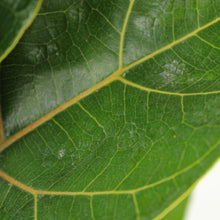Ficus lyrata is part of the Moraceae family and its native range is W. & W. Central Tropical Africa.
Leaves are large, coriaceous (leathery) and pandurate (fiddle-shaped), often with wavy margins. Potted young trees usually take a monopodial form, with a single non-branching stem; prune the growing tip or top the plant from an early age to encourage branching. 'Bambino' usually reaches a height of 1m in the home.
Genus name is from the Latin meaning ‘fig’, specific epithet is Latin, meaning lyre, this refers to the shape of the leaves.
Light: Bright indirect light, meaning the plant sees the sun for 0-4 hours per day - this could be through trees or a translucent curtain, it’s important for the plant to see the sky in order to thrive. 3-4 hours of direct sun is tolerable for Ficus.
Water: Allow the first 2-3 inches of the mix to dry out. Before watering, ensure the substrate isn’t compacted, if it is, aerate it with a few pokes of a skewer or blunt stick, pour water slowly over the top and allow the water to pass through the drainage holes.
Potting mix: A well draining mix composed of coco coir, perlite or vermiculite, orchid bark and worm castings.
Fertilising: Feed your plant every other watering during the growing season or when you observe active growth. You can dilute fertiliser to half the recommended amount but never add more.
Temperature: 18-27°C.
Humidity: Ficus would prefer higher humidity (over 60%) but do well to adapt to average home humidity. You can increase humidity by placing the plant on a watered pebble tray or using a humidifier.
Ficus lyrata is toxic, keep out of reach of pets and children.





